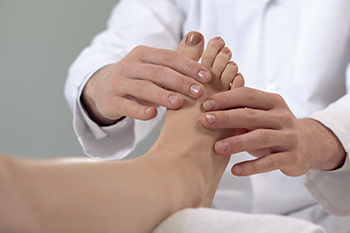
Dr. Kenneth Rosenthal
Dr. Jonathan C. O’Quinn
Dr. Michael J. Price

Dr. Kenneth Rosenthal
Dr. Jonathan C. O’Quinn
Dr. Michael J. Price

The pain that comes from the foot condition known as a heel spur is in the heel and lower leg. Many people who have this ailment liken it to stepping on a thumb tack, and it may feel worse in the morning after waking up but may diminish as a result of how mobility affects the feet. A heel spur looks like a small, pointed growth that develops on the heel bone. The plantar fascia can become irritated with a heel spur, which can often be mistaken for plantar fasciitis. Most heel spurs are small, and can be identified when an X-ray is taken. The Achilles tendon may be affected where it connects to the heel bone, and it can become painful. Common symptoms generally associated with a heel spur include difficulty in putting weight on the heel, warmness, and swelling. Research has indicated that most heel spurs develop from standing on hard surfaces for the majority of the day, or possibly from uneven pressure exerted while running or walking. If you have a heel spur, please confer with a podiatrist, who is the best type of doctor to offer you correct treatment solutions.
Heel spurs can be incredibly painful and sometimes may make you unable to participate in physical activities. To get medical care for your heel spurs, contact one of our podiatrists from Eastern Carolina Foot & Ankle Specialists. Our doctors will do everything possible to treat your condition.
Heels Spurs
Heel spurs are formed by calcium deposits on the back of the foot where the heel is. This can also be caused by small fragments of bone breaking off one section of the foot, attaching onto the back of the foot. Heel spurs can also be bone growth on the back of the foot and may grow in the direction of the arch of the foot.
Older individuals usually suffer from heel spurs and pain sometimes intensifies with age. One of the main condition's spurs are related to is plantar fasciitis.
Pain
The pain associated with spurs is often because of weight placed on the feet. When someone is walking, their entire weight is concentrated on the feet. Bone spurs then have the tendency to affect other bones and tissues around the foot. As the pain continues, the feet will become tender and sensitive over time.
Treatments
There are many ways to treat heel spurs. If one is suffering from heel spurs in conjunction with pain, there are several methods for healing. Medication, surgery, and herbal care are some options.
If you have any questions feel free to contact our office located in Greenville, NC . We offer the latest in diagnostic and treatment technology to meet your needs.